Apple Announces the iPhone 6s and iPhone 6s Plus
by Joshua Ho on September 9, 2015 7:14 PM EST- Posted in
- Smartphones
- Apple
- Mobile
- SoCs
- iPhone 6s
- iPhone 6s Plus
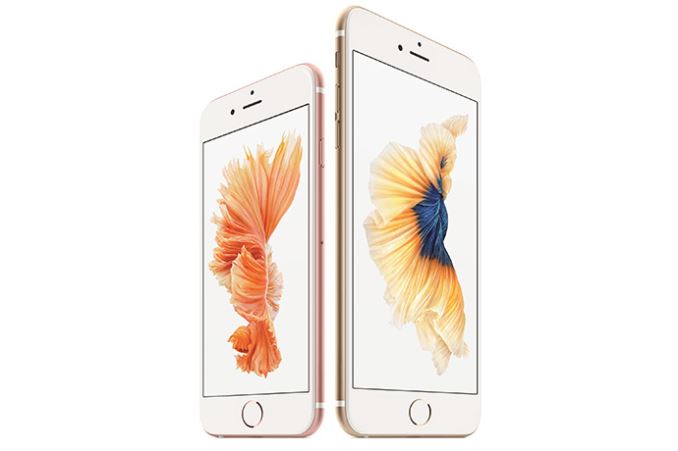
Today, Apple announced their refresh of the iPhone 6 lineup, the iPhone 6s and iPhone 6s Plus. For those that are unfamiliar with Apple’s “s” refreshes, these are years in which the iPhone doesn’t receive a visual design update but a number of internal aspects are significantly revised and updated. In the case of the iPhone 6s, this includes changes to display, SoC, new cameras, wireless connectivity, TouchID, and front-facing flash. I’ve summarized these changes in the table below.
| Apple iPhone Generations | ||||
| Apple iPhone 6 | Apple iPhone 6 Plus | Apple iPhone 6s | Apple iPhone 6s Plus | |
| SoC | Apple A8 | Apple A9 | ||
| Display | 4.7-inch 1334 x 750 IPS LCD | 5.5-inch 1920 x 1080 IPS LCD | 4.7-inch 1334 x 750 IPS LCD | 5.5-inch 1920 x 1080 IPS LCD |
| WiFi | 2.4/5GHz 1x1 802.11a/b/g/n/ac, BT 4.2, NFC | 2.4/5GHz 2x2 802.11a/b/g/n/ac, BT 4.2, NFC | ||
| Storage | 16GB/64GB/128GB | |||
| I/O | Lightning connector, 3.5mm headset | |||
| Size / Mass | 138.1 x 67 x 6.9 mm, 129 grams | 158.1 x 77.8 x 7.1 mm, 172 grams | 138.3 x 67.1 x 7.1 mm, 143 grams | 158.2 x 77.9 x 7.3mm, 192 grams |
| Camera | Rear Facing 8MP iSight with 1.5µm pixels + True Tone Flash Front Facing 1.2MP f/2.2 |
Rear Facing 8MP iSight with 1.5µm pixels + True Tone Flash + OIS Front Facing 1.2MP f/2.2 |
Rear Facing 12MP iSight with 1.22µm pixels + True Tone Flash Front Facing 5MP f/2.2 |
Rear Facing 12MP iSight with 1.22µm pixels + True Tone Flash + OIS Front Facing 5MP f/2.2 |
| Price | $99 (16GB) | $199 (16GB) | $199/299/399 16/64/128GB | $299/399/499 16/64/128GB |
For the most part, it’s really rather difficult to talk in great depth about these changes because right now we don’t have a lot of detail which will probably be saved for a full review. One example of something that we can’t test or really notice at all is the change to the build materials. While the display glass is still glass, Apple is claiming the strength of this cover glass is greatly improved from the iPhone 6. The aluminum of the back cover has also been strengthened, with the iPhone 6s using a custom 7000-series aluminum alloy to improve strength.
On the display side of things Apple has added a precise force sensing layer to the display module which allows for a whole range of new interactions with the smartphone. This force sensing technology is called 3D Touch by Apple, to differentiate from Force Touch on Apple Watch which is basically just a single force sensor to allow for a single force gesture within a context. The addition of a taptic engine helps to enable strong and useful haptic feedback when using 3D Touch gestures. While not part of the display, TouchID has also improved to enable much faster unlock speed.
The SoC is also brand-new and much faster. Apple disclosed up to 70% CPU performance improvement and 90% GPU performance improvement, and is built on a leading edge FinFET process. Judging by the lack of disclosure of specific process node the possibility that A9 will be using both Samsung 14nm and TSMC 16nm still exists. The Apple A9 SoC in the iPhone 6s will also have the M9 motion coprocessor built into the SoC itself, which should improve power efficiency by virtue of being on a leading-edge process rather than lagging behind on 28nm or something similar. The addition of always-on Siri voice activation is also possible due to the new A9 SoC.
The new camera is also part of the major announcement this time around as the iPhone 6s now has a higher resolution to support 4K video recording. This new camera is 12MP, with 1.22 micron pixel size which means that sensor size is effectively identical to the iPhone 6 and 5s at 1/3”. Technologies like deep trench isolation and modified color filter array are said to help with low light performance. Deep trench isolation has been seen before in camera sensors like the One M7 ST-Micro Cinesensor/Ultrapixel sensor, and Samsung’s ISOCELL sensors, which is likely needed in order to drive these smaller pixel sizes.
The front-facing camera has also been updated to a 5MP unit, with a display flash mode to enable low light selfies. Using the display for flash has been done before by companies like LG, but Apple’s claim for differentiation is that they’re detecting ambient light and using their display LED driver to boost LED brightness up to 3x the maximum brightness of the display in normal operation with the right white balance to ensure good color rendering.
The camera will also have Live Photos, which captures a photo that is a short moment in time with sound, which could also be said to be a video. If this sounds a lot like HTC’s Zoe feature, it’s probably because it definitely shares some similarities in that regard. However, as far as I can tell unlike HTC’s implementation Live Photos is mostly seamless and only shows animation when you do a force touch or if you’re swiping from one photo to another in the gallery.
On the wireless side, the iPhone 6s brings LTE-A with speeds of up to 300 Mbps. The modem design win wasn’t disclosed, but it’s probable that Qualcomm’s Gobi modems are in at least some iPhone 6s variants. Apple did disclose that the iPhone 6s can support up to 23 LTE bands, which makes the iPhone 6s one of the closest phones to single global SKU on the market today.
WiFi is also improved with two spatial streams for up to 866 Mbps on 5 GHz 802.11ac. The two antennas are likely to be integrated into the top and bottom metal sections of the phone, which likely means that peak WiFi performance will have to be achieved by not touching either section. Of course, this isn’t going to be another antennagate though because it’s likely that all RF that relies on the lower antenna to work will also have an antenna tuner to reduce detuning effects.
The iPhone 6s and 6s Plus will go on sale starting September 25th, and preorders begin September 12th. Pricing will be identical to the iPhone 6 last year, with the 16GB 6s starting at 199.99 USD on contract and the 16GB 6s Plus starting at 299.99 USD on contract. Unlocked pricing is likely to start at 649.99 USD and 749.99 USD respectively. Both phones will be available in silver, space gray, gold, and rose gold.


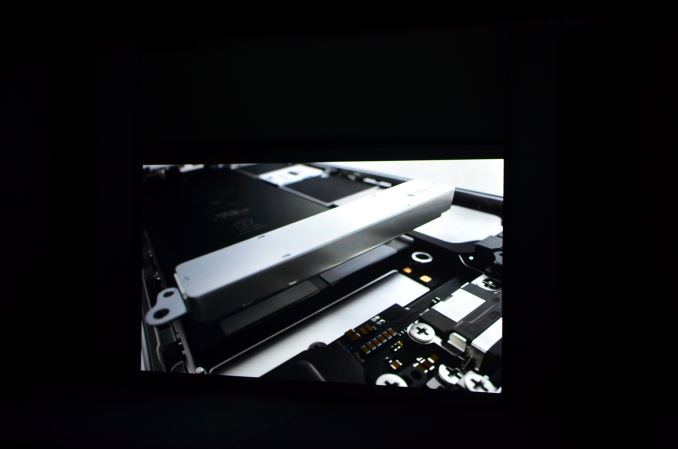

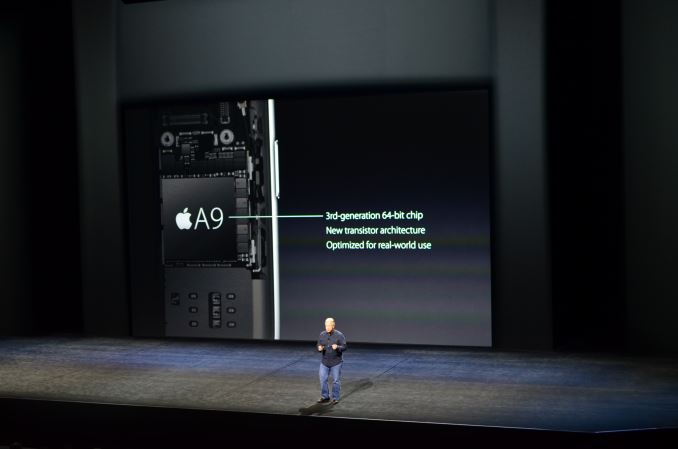
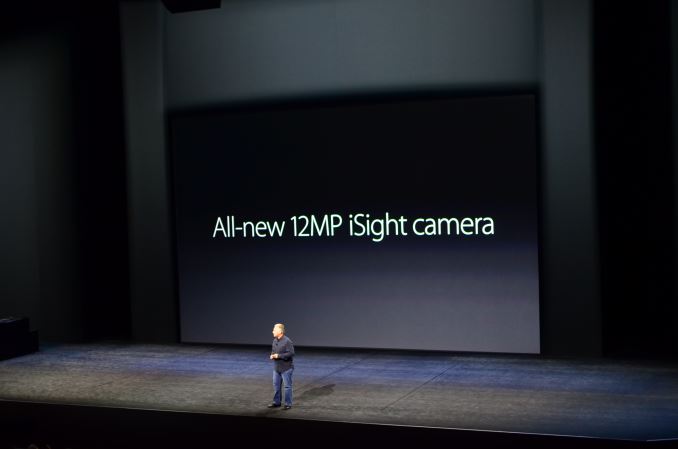
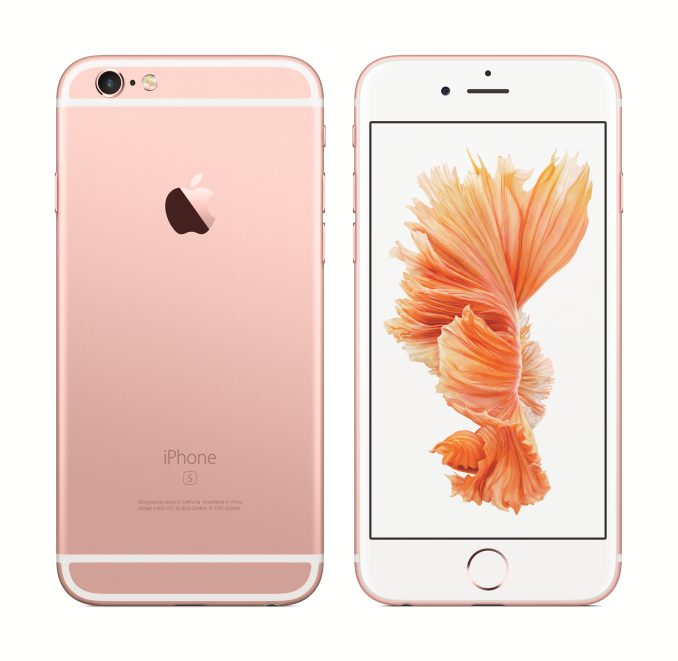
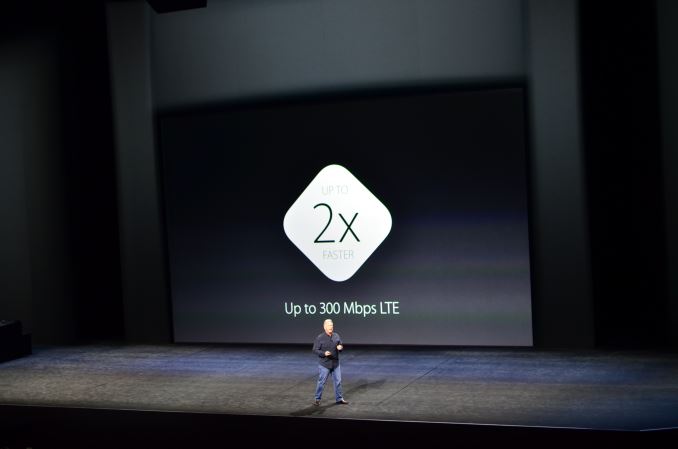
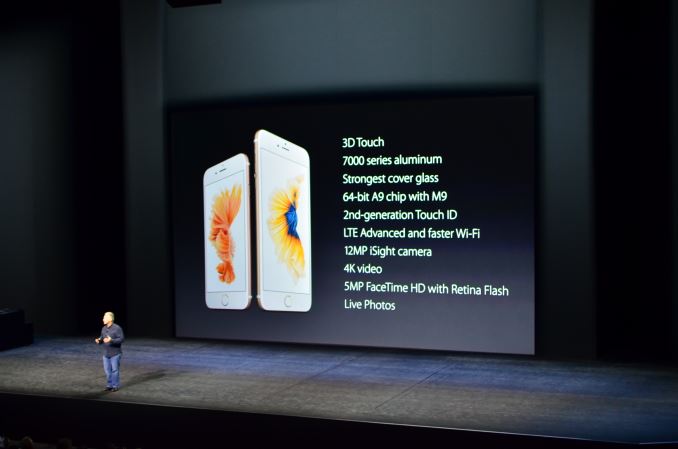









62 Comments
View All Comments
WaltFrench - Thursday, September 10, 2015 - link
Sensor analysis isn't as easy as “more megapixels!” but it doesn't mean you have to ignore the basic physics.Silicon sensors, for a given process, have a roughly constant amount of noise per unit of area, while the signal gets proportionately stronger. Cutting pixel size reduces the noise but reduces the signal more, a lousier signal-to-noise ratio per pixel. But when you look at a picture from a 12MP sensor versus an 8MP sensor, you see the same amount of noise <i>per picture.</i>
Or approximately. Smaller pixels mean a slightly worse ratio of wasted space around each pixel, mostly due to proportionately more insulation between them. That's a secondary effect, tho, which could be offset by improvements elsewhere.
Net-net, more pixels undeniably give you more flexibility in shooting and editing, but zooming in might not look quite as good, particularly in low light when noise becomes more visible.
Dinging AnandTech for favorably reporting the combo of more pixels, better color purity (those deep wells) and a bunch of nice software features is just trolling. With adequate software—and evidence is that Apple's is more than adequate—there's no reason the photos won't be noticeably nicer.
Zizy - Thursday, September 10, 2015 - link
Next gen sensors are better than the previous gen, so the camera will be better.As for larger pixels vs smaller (same tech and total sensor area):
For FSI, larger pixels let in more light => better low light performance, despite lower pixel count and less options for post-processing.
With BSI, that advantage goes mostly away. Total area for light collection is almost the same. Therefore the amount of photons collected by both sensors will be the same. Smaller pixels have obvious advantage of resolution. This alone means results will almost always be better than with larger pixels.
Larger pixels have some not-as-obvious advantages: Larger pixels can collect more light before getting saturated => more range. In addition to shot noise (photons), there is also sensor noise (electrons). I have no values for often used stuff in cameras and can't be bothered to find some, but I guess it is at least several photons of noise, likely 10s of photons. This means larger pixels will be able to use slightly shorter times => less blur. But the advantage is relatively slight.
BurntMyBacon - Thursday, September 10, 2015 - link
I would note that smaller pixels loose proportionately more space to insulation between pixels in addition to having more pixels to insulate. Two sensors of the same size, but different resolution do not in fact collect the same amount of photons. That said, if the difference in pixel size isn't that large, then the difference isn't very notable and post processing algorithms can go a long way in rectifying the issue. Most phones don't have a way to force RAW capture, so the quality of the post processing is often more important to a phone than the pixel size.Synomenon - Wednesday, September 9, 2015 - link
I know iOS is an efficient OS, but still only 1GB of RAM or is there more now?JoshHo - Wednesday, September 9, 2015 - link
We don't have any information on that. There are rumors, but we don't consider rumors or speculation to be a valid source.Morawka - Wednesday, September 9, 2015 - link
Why don't you guys just straight up ask apple reps at the try on tables? If they say "we dont disclose that" then that is seriously messed updanbob999 - Thursday, September 10, 2015 - link
Good attitude, especially since just about every reviewer was wrong assuming the iPhone had 1GB when they stuck with 512 MB.akdj - Friday, September 11, 2015 - link
? Four years ago?I suppose that's what I enjoy about this site. No 'race to review'. Time spent in the lab, real world and differing conditions as well as excellent writing and in depth discovery is sow,thing I can always count on here
And one needs look no further than (original) S6 review if they want to ensure non bias Android/iOS reviewing
3DoubleD - Wednesday, September 9, 2015 - link
How much RAM does it have? This important detail appears to be absent.TheSlamma - Wednesday, September 9, 2015 - link
2GB